Resilient Australia Awards 2016
Hansika Bhagani, Australian Institute for Disaster Resilience
Article
The 2016 Resilient Australia Awards were celebrated in November 2016. The Awards recognise innovative practices and achievements that make communities safer, stronger, more resilient and better prepared to manage emergencies. There are three categories of awards: national (covering community, business and government), school and photography. This year individuals, groups and organisations demonstrated how they are helping communities be resilient.
Survive and thrive: empowered students build bushfire resilience
Many in the Victorian town of Anglesea remember the 1983 Ash Wednesday fires that destroyed 140 homes and killed several people. In the years since the fires, Anglesea, on the Great Ocean Road in Victoria, has faced more bushfires. Alongside other communities on the Otway Coast, the community has embraced a number of initiatives in order to reduce their vulnerability to fires.
One of the initiatives has been for the students of Anglesea Primary School, where the Country Fire Authority’s (CFA) ‘Survive and Thrive’ program has been running. The program won the 2016 Resilient Australia National School Award for its strong focus on sustainable long-term resilience. The program is run for students from Year 4 to Year 6 and aims to empower them with knowledge and understanding of bushfire behaviour. Students are asked to be educators, leading community-based bushfire education and preparedness activities for themselves, their families, their community, local communities and visiting schools. They are tasked as researchers, engaging with the environment and technology, interviewing and consulting with community members, recording phases of the project and sharing their learnings. They also explore their role as environmental agents, being involved in local contemporary opportunities or challenges and devising community messages about environmental care.
Emma Taunt is the CFA Survive and Thrive program coordinator for both Anglesea and Strathewen primary schools. She explained the program works because of strong buy-in from the schools, parents and teachers.
‘The success of it is built on many minds coming together, championed by Jamie McKenzie [CFA Leadership Program Coordinator] and his very extensive professional and social network. When they were looking at building the new Angelsea fire station they didn’t want to just build something basic. They wanted something that could be accessed and shared within the community. Part of that vision included the education element. Once that space started to exist, more people came together,’ she said.
Strong support from the school is demonstrated by the amount of time devoted to the program in the curriculum. The program is embedded into student timetables for two hours a week throughout an entire year, allowing them the time to lead workshops, presentations and exhibitions.
‘The way that the CFA program works allows the teachers to achieve a lot of the actual curriculum outcomes that are expected at the state and national level. If we were just doing a few sessions that may not be the case, but transitioning the kids from being the learners to being the teachers and solving very complex problems—they’re expected to create a workshop that’s relevant and engaging to their family—means they start playing around in drama, art and the science space in a really different way. As far as reaching curriculum needs, it ticks those boxes at the same time,’ she said.
The program is also adaptable to the differences in each class as they advance through the program in years 4, 5 and 6.
‘The whole program is built on innovation and adaptability. The kids are so different at each year level. They’ve all grown up together and there’s between 10 and 20 students in a year level. With that the personalities and interests of the kids are quite pronounced. Each year what they’ve shown more interest in has grown and we’ve learnt what worked well, so we adapt the program to keep rolling with that. We link in as much as we can with the right people who have information that extends beyond us. We bring in Parks Victoria, people from the Department of Environment, Land, Water and Planning, from VicPol and from Emergency Management Victoria. We link them into where the kids are at and where they’re trying to go,’ she said. She noted as an example the fire at Wye River in January 2016.
‘We tap into where the kids are at. Knowing that the Wye River fire was on their mind and they had their own ideas about what had happened and what it meant to them, we adapted around that. We took them on an excursion down there and had discussions around their experience of the fire. We know the building blocks behind what we’d like them to know by the end of the two years. But we try to stay as open as we can to where that engagement level is at,’ she said.
The program is scalable to different disasters, different partnership models and different time lengths.
‘You could have less support and do a smaller-scaled version. You might drill down to one hazard, and do it for a term, or even just a focus project, so there’s no burden on the school. Most importantly, it’s about teaching all of the kids a real breadth of knowledge and them being able to explore it in their own way. Not every school, not every community, not every risk is the same. But teaching resilience means the whole concept of what we do is adaptable and unique and relevant to the audience,’ she said.

Dr John Bates, Andrew Rankin, AIDR, Anglesea Fire Brigade, Emma Taunt, CFA, Pamela Sandlant, Anglesea Primary School, Jamie MacKenzie, CFA, Mark Crosweller, Director General Emergency Management Australia and Craig Lapsley, Victoria Emergency Management Commissioner. Image: Australian Institute for Disaster Resilience
Collaborating for disaster response
When Cyclone Yasi hit north Queensland in 2011, the major cities of Cairns and Townsville were heavily effected. In Townsville large trees were uprooted and power lines were brought down that resulted in power loss for seven days.
The 600-strong residents of the Carlyle Gardens Retirement Village were prepared for the eventuality, having formed a small group to investigate the best way that residents could look after themselves in disaster. John Wilson, a resident of the village, is one of the founding members.
‘There was a group of about five that got together one day after the 2005-06 cyclone season. We had had a couple of cyclones off the coast and we thought at some stage we’re likely to get a cyclone here that’s going to cause a concern. We decided we should do something to help those elderly people, especially widows and widowers, who would find it difficult to look after themselves in a disaster. We formed a committee and we got some money out of our social club to buy some portable radios. Then we managed to get a $3000 government grant from which we bought a generator,’ he said.
When Cyclone Yasi hit, John and his committee members were able to put their plan into action.
‘We managed to obtain food by clearing the freezers and fridges of those people who were away. They were very grateful for that because otherwise their freezers and fridges would have been destroyed. We found enough food from fridges and pantries across the village to take care of people over that period and they were extremely grateful for what we did,’ he said.
They moved the food into a central location that was maintained by a backup generator allowing the community to maintain self-sufficiency without reliance on emergency providers or the local disaster management group.
Since then the committee has formalised into the Carlyle Gardens Disaster Management Group. The group has a governance structure incorporating an executive (two residents), venue management representing Lendlease, five operations staff (residents) who maintain a command post during disasters and 60 area marshals. The group meets regularly, maintains a comprehensive Disaster Management Plan and conducts a post-event analysis consisting of debrief, evaluation and formal report to management.
The Disaster Management Plan outlines preparedness activities, hazard information guides, a marshal system to account for and assist all residents, evacuation procedures, establishing an internal evacuation centre and development of checklists. The plan notes that with the established emergency power generation, an internal evacuation centre at the theatre, and a protocol for collecting food from residents, that the community is able to support itself for several days post an event without any reliance on external emergency and community support.
Although the plan and arrangements for disaster response and recovery are comprehensive, Mr Wilson insisted it can be done by any community or small town.
‘It just happened to be a group of mainly ex-servicemen who started it. However, it’s not a military exercise. There are many other people who are quite capable of doing the same job,’ he said.
In addition to establishing a plan, communicating it to all residents is key.
‘I think we’ve done rather well, but we’re always developing it further; writing instructions and different things like that. We have produced books and instructions for our residents. Every new resident who moves in gets a booklet on our guidelines to read and study. I’m sure that as time goes by, we’ll find that we need to change and to improve. But we felt like we could do something and, over the years, it’s worked well,’ he said.
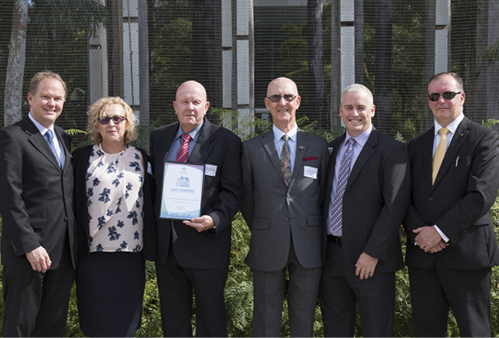
Dr John Bates, AIDR, Jo-ann Veitch, Carlyle Gardens Retirement Village, Mike McCloskey, John Wilson, Peter Steyger, Queensland Police Service and Mark Crosweller, Director General Emergency Management Australia. Image: Australian Institute for Disaster Resilience
A lifesaver for the Sunshine Coast
The 2016 Resilient Australia National Award was won by the Sunshine Coast’s Disaster Hub—a portal that provides comprehensive, centralised and real-time information for the public, media and external agencies to access before, during and after disaster events.
Spearheading the design and implementation of the Disaster Hub has been John Gallina, Disaster Management Coordinator at Sunshine Coast Council.
‘We started the development of the Hub back in 2012. It began as a consequence of the Queensland floods in 2010-2011. There was a huge range of recommendations for local government that came out in the interim report and final reports from the Queensland Flood Commissioner Inquiry. We identified that a good communications platform that can provide information to the community and help make real-time decisions in disaster coordination centres would address a lot of those recommendations. That was how the concept of Disaster Hub developed in 2012,’ he said.
The Hub is divided into a public-facing site and a site for registered users to log in and view live data that can assist in decision-making. The public site provides information about preparing for, responding to, and recovering after the event. It is especially useful during events when warnings, road closures and evacuation centres can be quickly found by a glance at the main page.
On the other side of the site, logging in as a registered user brings up a dynamic interface for disaster management decision-making during a disaster. The site uses open standards, interoperability, security, data protection and scalability. When combined, both platforms enable council to work with external agencies and the community by sharing mission-critical information.
Despite the complexity of the information sources and requirements of both sides of the website, the website boasts a surprisingly simple interface.
‘Our project team made sure the site was intuitive and easy to use. It had to work on all types of technology—every common type of mobile device, computer and tablet. You should be able to follow your nose and find what you’re looking for,’ said Mr Gallina.
The Disaster Hub has been used in emergency management exercises and shown its form during real events on the coast, noted Mr Gallina.
‘We launched it in December 2014. During Cyclone Marcia in February 2015, we had over 293,000 page views. So there was great uptake from the community in using the site and we’ve gone from strength to strength.
‘As well as the local community, we are investing to make sure tourists and visitors to the Sunshine Coast are aware of the site. Our Economic Development Department reach out to the business industry so that they’re filtering information out through organisations that manage tourism. We also regularly inform people about the Disaster Hub through local media, through our print media, our TV stations and our radio stations on the Sunshine Coast. We’re continually pushing that message out there—if you need to know what to do before, during and after a disaster, go to the Disaster Hub,’ he said.
The platform is frequently reviewed as the team look for ways it can be improved and adapted to different disaster scenarios and made available to other areas.
‘We’re due to launch Stage 4 shortly. Up until this time the Disaster Hub has been built on the Sunshine Coast. The Stage 4 version is a model that can be very quickly adapted to any local government area in Australia. The new site is configured for all the local government areas in Queensland. The platform that it’s built on also quickly opens up that functionality for all places in Australia. We’re quite excited about that and where Disaster Hub may go in the future,’ he said.
One of the other key features Mr Gallina is working on is to improve its functionality for Queensland Police Service (QPS). A pilot is underway between council and QPS to investigate its disaster impact functionality to incorporate policing geospatial data relating to counter terrorism, bomb threats, hostage sieges, public safety cordons, repeat offenders and persons of interest. This combination of disaster-related geospatial data and policing data, for any specified location at any time, would provide immediate intelligence to QPS for any sudden onset policing or national security-related incident. Mr Gallina is hopeful about what this might look like in practice.
‘The police could use Disaster Hub to do a geofence around the area they are concerned about, run an impact assessment report and it will bring up key things in that location like schools, childcare centres, nursing homes; anything that’s critical infrastructure that’s of concern in that location. Instead of trying to Google what might be there, you just draw a circle or a fence around the area you’re concerned about, hit a button on Disaster Hub and 15 seconds later you’ve got a report about the things in that location that may be of concern to police and a contact number. There may be an incident where they need to ring a school principal and say “you need to lock down the school”. That’s a part of the functionality of Disaster Hub that we think is extremely beneficial for policing issues, and it’s for use every minute of the day,’ he said.
However, Disaster Hub is just one canon in the arsenal, Mr Gallina noted.
‘Disaster management is something you have to do on a daily basis with your community to educate people what to do before and what to do after. Having a single point of truth that they can go to for the right information when they need it is a pretty important part of that,’ he said.
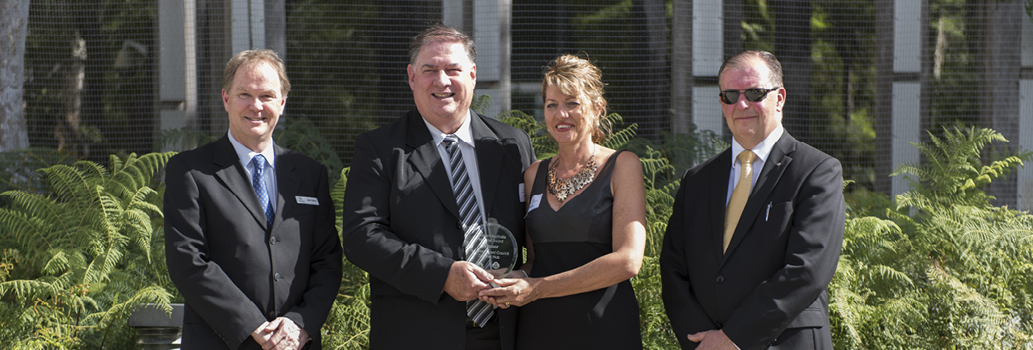
Dr John Bates, AIDR, John Gallina and Shirley Hall, Sunshine Coast Council and Mark Crosweller, Director General Emergency Management Australia. Image: Australian Institute for Disaster Resilience
Council raises awareness of heatwave risks
Yarra City Council in Victoria was one of the highly commended entries for the 2016 Resilient Australia National Award for its innovative ‘Keep Cool in Yarra’ program aimed at increasing awareness of heatwave risks in local migrant communities living in social and public housing.
The Council partnered with 25 agencies and community groups to deliver ‘Keep Cool in Yarra’, which involved a major media campaign along with public information, promotional materials and community information sessions to educate and raise awareness of the health risks of heatwaves.
Lucy Saaroni, Senior Advisor Emergency and Risk Management at Yarra City Council helped develop the program that was put together with input from multiple partners and stakeholders.
‘Yarra is a particularly multicultural and diverse municipality. We have a lot of people living in a small area. We met up with a number of different cultural groups and networks to draft this campaign. We asked the questions at the very beginning: “What is it that you’re wanting and what is it that you don’t have?” We learnt a lot and that defined our campaign,’ she said.
Targeting migrant groups and the deaf community, Ms Saaroni said she found a diversity of approaches was required.
‘There wasn’t a particular trend because we were dealing with so many different language and cultural groups. But there were trends within each group. The Arabic speakers were particularly interested in our A3 posters. When we asked why they wanted to take an A3-size branded poster home they said: “Our children are not speaking Arabic at home. They’re learning English at school. This is a way for us to connect with our kids because they’re going to have to ask us what this means if I put it up”. That was a fascinating learning experience for us. It showed us there were additional benefits to what we were doing, like bringing families closer.
‘The Greek community loved the thermometer magnets. That may be a reflection of the cultural attachment to the home and to the kitchen. It may be something they’ll see every few hours as they visit their fridge. Our Vietnamese community went crazy over the fans. The public housing tenants were much more interested in information about where to go in their area when it gets hot. They weren’t interested in the freebies. Every group had a different reaction to what we were doing. It was overwhelmingly positive, but for different reasons,’ she said.
Leaning on partners to assist was especially helpful, noted Ms Saaroni.
‘We learnt how much we could do with a little bit of money and a lot of goodwill. We had set aside a budget for this and we underspent by 70 per cent because we had so much assistance from all these willing participants—associations, community groups, neighbourhood houses, police, volunteers from the Australian Red Cross.
‘Some of the groups are now working under their own steam, which is fantastic. We presented to a group at the Finbar Neighbourhood House. They were so engaged and wanted to do something more, so they went off and made cooling neckties—you put them in water and they expand and develop into a cooling gel. We got the materials and crystals for them and they did the rest themselves. They know who their vulnerable people are and they can give them out, which is great.
‘The other thing we learnt from the project was that a one-size-fits-all resilience building approach won’t work. You have to drill down and work piece-by-piece on community resilience building, because the community isn’t one homogenous group. It is made up of much smaller subsections and individuals. You can’t try and be everything to everyone. We’ll be taking this approach and applying it in other areas in future to target different vulnerable groups for different hazards,’ she said.
Overall Ms Saaroni said the project succeeded because of an ethos of shared responsibility.
‘Everyone has a stake in safety. Everyone has a stake in emergency management and it was fantastic to see the willingness and participation of the groups in terms of managing their risks,’ she said.
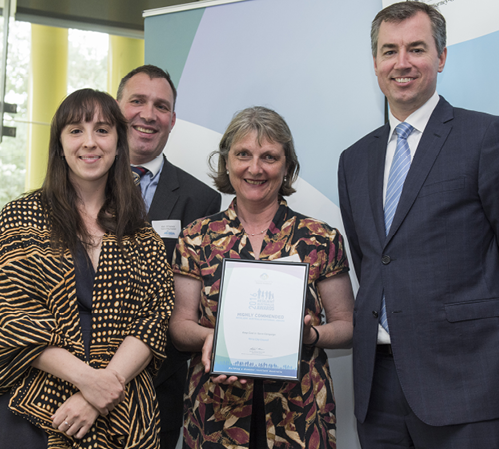
Lucy Saaroni, Kim O’Connor and Mayor Amanda Stone, Yarra City Council, with The Hon. Michael Keenan MP at the 2016 Resilient Australia Awards National Ceremony. Image: Australian Institute for Disaster Resilience
The face of resilience
On 20 February 2015, Tropical Cyclone Marcia crossed Queensland’s Capricorn Coast, making landfall at Shoalwater Bay and going on to affect Yeppoon and the regional city of Rockhampton before moving back out to sea and dissolving. The cyclone caused over $750 million in damages, including the repair bill for vital public infrastructure.
Albany-based photographer, Karin Calvert covered the devastating event for Getty and Associated Press. A year later she returned to mark the anniversary. ‘Twenty: Cyclone Marcia - Rescue, Resilience, Recovery’ is her photographic story of the people of Livingstone Shire who were instrumental in the rescue and recovery efforts.
The first portrait she took was of then 73-year-old Bob Jeacocke. Bob is a Yeppoon resident and SES volunteer of over 42 years whom Calvert says epitomises resilience.
‘That strength and the dedication to community just shines out of him. I think that’s what people love about that photograph. It doesn’t need words. It illustrates the presence, the strength and the depth of coverage of the volunteer services. On a personal level Bob just shines that, so I think it’s a successful image in that way,’ she said.
For Bob the image is a reminder of everything he and other emergency services volunteers went through after the cyclone.
‘It was a hectic time. We were involved in helping out people who were stranded in water, getting them out with flood boats. We were chain-sawing trees on roads so people could get in and out. We were roof-tarping houses where it was possible, although there were lot of houses that we couldn’t do. They were just too far gone. So we gave them tarps to put over their furniture when the furniture dried out a bit,’ he said.
Bob spent days away from his family, travelling west to Yaamba and Milman to help the relief efforts there.
‘I spent most of my time up in the Yaamba and Milman areas because the team leader up there was in Mackay with a broken hand. So they sent me up to assist them and I was travelling there from Yeppoon every day, getting up early and getting home around 9pm at night,’ he said.
It’s something Bob was well prepared for, having signed up with Queensland SES when it began in 1975.
‘We had started the SES in 1975 and our first big event was Cyclone David in January 1976. We were fairly raw and at the time it happened our controller was in Melbourne. I was deputy at the time and there was quite a lot that fell on me. That was my baptism of fire,’ said Mr Jeacocke.
Now part of the Yeppoon Group in the Livingstone Shire Unit, he’s geared up for another summer and whatever comes with it.
‘All our groups are getting ready for the summer and the possibilities of the summer. We’re ready if anything does happen. But no matter how well you prepare, there’s always something that comes up that you’re not prepared for,’ he said.
Reflecting on the 2016 Resilient Australia National Photography Award, Mr Jeacocke notes the award is something all frontline emergency service volunteers can take pride in.
‘This award was one of the major highlights of my life. I was presented with an emergency services medal by the Governor in Brisbane and that was a real big highlight. This has far exceeded that; far bettered that. I just couldn’t believe it could happen. But the photography award was also for all the emergency services frontline people; the police, the paramedics, firefighters, particularly rural firefighters, SES volunteers and the coast guard. Most of those people are volunteers and I’d like to say I did it for them. Those volunteers turn up every time they’re needed and put their best efforts in,’ he said.
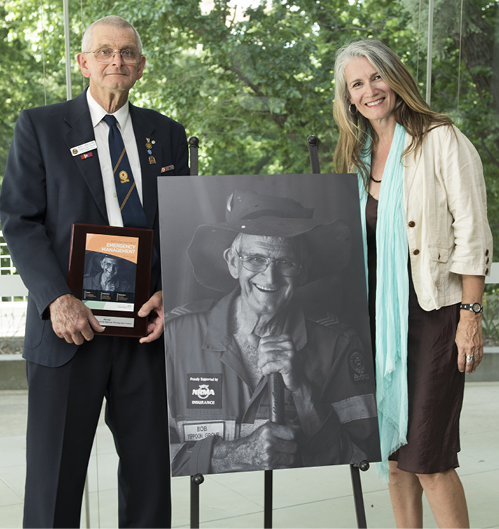
Bob Jeacocke and Karin Calvert with the 2016 Resilient Australia National Photography Award winning portrait. Image: Australian Institute for Disaster Resilience
Fire rages
Glenn Daniels remembers well the day he drove down to Kyneton, Victoria and took the photo that become a finalist in the 2016 Resilient Australia National Photography Award.
‘I went down there and the police had blocked off the roads. The police officer let me through and I followed a fire truck until I could find an incident controller. I was actually in the bush that’s on fire with two fire crews when they said we’re pulling out. The reason why they were so worried was that there was a wind change coming. We pulled out and the fire creeped to the edge of where we were and then the wind changed. That’s when it started crowning at the top. The CFA had strategically set themselves up so that they weren’t fighting the fire in there but were holding back in the clear paddock just to put out the spots so it wouldn’t advance any further than that.
‘The heat was intense. I knew I was safe. But there was a fear of “I can’t run now. I’ve got to stay where I am”. There’s a sense of loss of power or control within the situation. I set myself up right in the right place so I was safe. Logistically and strategically how the CFA handled the situation was an absolute testament to what they do. That’s why I entered it into the Resilient Australia Awards,’ said Mr Daniels.
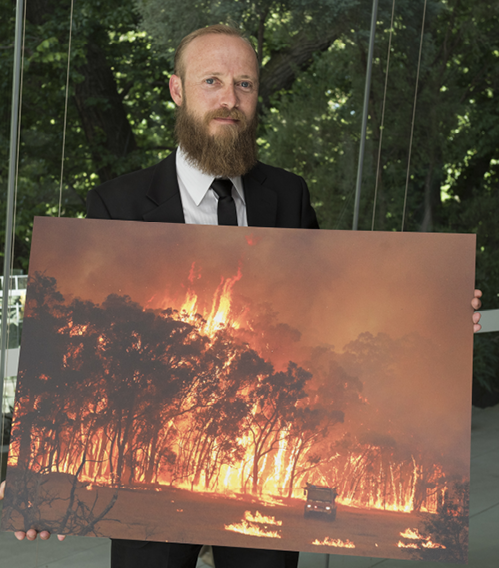
Glenn Daniels, Bendigo Advertiser, with his photo ‘Fire rages’. Image: Australian Institute for Disaster Resilience
By air and by sea
Volunteer Marine Rescue training exercises can be multifaceted and complex. When amateur photographer and volunteer Jason Harris saw an opportunity to document one held in Jurien Bay, Western Australia, he jumped at the chance. His photo became a finalist in the 2016 Resilient Australia National Photography Award.
‘On the day of the joint training exercise we went to the airfield to meet the helicopter. We were given a briefing on the capabilities of a helicopter; the things to look out for and the types of activities we would do. Then we all went out to the bay, launched the boats, and the paramedic winched on and off each of the rescue boats. I was actually going to be on the boat as crew. But I thought it was a good opportunity to take some pictures as there wasn’t anyone else in the group who was going to be doing that. I found out we’d organised a boat as DFES (Western Australia’s Department of Fire and Emergency Services) were doing some filming as well. So I said I’ll jump on that,’ he said.
The Volunteer Marine Rescue in Jurien Bay has approximately 50 volunteers who aid stranded mariners, explained Mr Harris. As well as search and rescue they need to be trained in dealing with injuries, working at high speeds and in difficult conditions.
‘The thing that the picture doesn’t quite capture is that it’s all happening at about 15-20 km an hour. What we’re doing on the boat is preparing it, taking anything that can blow around and removing it from the back deck. We’ve got to pad things, like a big post that’s in the back for towing, so that the paramedic as they’re coming down, doesn’t injure themselves banging into it. Then we get inside and out of the way, as the person driving the boat maintains a straight course as directed by the helicopter pilot, so that he can move into position the paramedic on the boat, and back up again,’ he said.
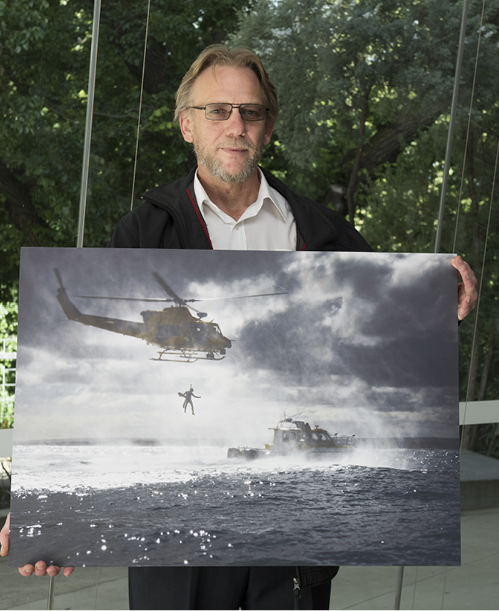
Jason Harris with his photo ‘By air and by sea’. Image: Australian Institute for Disaster Resilience
The Resilient Australia Awards are an Australian Government initiative sponsored by the Attorney-General’s Department in conjunction with states and territories. Information about the Awards is at: www.ag.gov.au/EmergencyManagement/Resilient-Australia-Awards.


